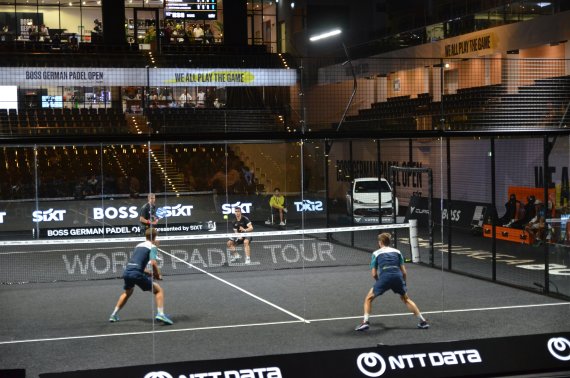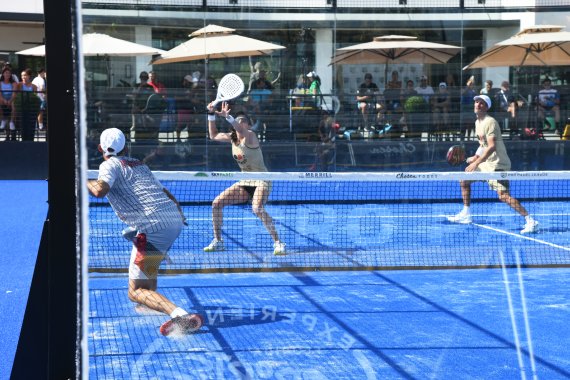- The secret of padel's success: the incredibly steep learning curve and fun teamwork
- Global spread and boom of padel courts
- Padel growth in Germany: catching up and potential
- The economic potential of padel
- "Skills shortage" in padel too
- Addictive factor: the refreshing social component of padel
- Conclusion
If you ask the aforementioned passer-by question in Spain, the answer will most likely include an invitation to play a match together. Because in Spain, over a million enthusiastic "padeleros" are already chasing after the yellow ball in the box - and they do so on over 16,000 padel courts spread across Spain. In comparison: in Germany, the still manageable fan community is currently content with just 500 padel courts, which are currently booked out accordingly when the weather permits a padel match. And all it takes is dry conditions and temperatures above zero degrees - because padel is a good option for having fun even in calm winter weather thanks to the windproof screens.
The sustainable boom in padel can also be explained by the fact that athletes who have a certain feel for the ball can experience exciting matches on the padel court after just a short time. Sports scientist and rebound sports coach Andreas Ehstand explains: "The stroke variations are usually much more compact and quicker to learn than in tennis, for example. What's more, the glass and metal court boundaries mean that the rallies can be much longer and therefore often subjectively much more exciting than in other backstroke sports. The teams of two on each side of the court - through constant verbal and non-verbal communication - lead to a much more social playing experience, which many players feel and carry on beyond the game, especially after Corona, in the entire social sports structure around the courts and in the often nearby sports restaurants."
Just how energetically padel is progressing worldwide has even attracted the attention of economic experts from Deloitte, who, together with the global booking and appointment platform Playtomic, have been approaching the phenomenon of padel from an economic perspective once a year for the past three years. The current edition of the report states that in 2023 alone, over 2,657 new padel clubs were opened worldwide - that equates to more than 50 new clubs per week. This dynamic shows how quickly the sport is establishing itself globally. It is particularly remarkable that the report for 2026 estimates a number of 70,000 (in 2023 there were 40,000) padel courts worldwide by 2026, which corresponds to an almost doubling of the current number of courts. Growth will be driven by the increasing demand for courts in new markets - particularly in countries where padel has only become popular in recent years, such as the USA, France and Germany.
The report particularly highlights the markets where padel is currently in a boom phase. Spain remains the Mecca of padel sports with over 16,000 courts in 2023, followed by countries such as Italy (6,470 courts) and Sweden (4,200 courts). It is interesting to note that padel is also establishing itself strongly in countries with colder climatic conditions, such as Finland and Norway. There are already more than 1,000 padel courts in operation there, although many of them are indoor courts.
Growth is particularly strong in Germany. While the country still lags behind the rest of Europe, there is enormous potential to catch up here. In 2023, the number of padel courts in Germany rose to 420, and the number of players licensed by the German Padel Association grew from 1,100 in 2022 to 2,500 in the following year. These increases indicate that Germany could play a central role in the European padel scene in the coming years. In addition to the German Padel Association (DPV), which is responsible for coach training, national teams and association matches and is part of the world federation FIP, the German Tennis Federation (DTB, the largest tennis federation in the world) has also discovered the enormous potential of padel. Those responsible at the DTB see excellent opportunities for established tennis clubs to breathe a new youthful and fun-oriented spirit into the club through additional padel courts and, in the long term, to inspire new target groups for the development of the sport of tennis with the padel offer.

The Global Padel Report not only sheds light on the development of new court construction, but also provides economic forecasts for operators and the sports industry.
In this year's edition of the report, the global padel market was estimated at 2 billion euros in 2023. This market includes revenue from court rental, the sale of rackets, balls and clothing. The sale of padel rackets in particular is booming: over 6 million padel rackets were sold worldwide in 2023. This shows how much interest there is in the sport and how much the industry around padel is growing.
The forecasts for the future are impressive: the global padel market is set to grow to 6 billion euros by 2026. This means a tripling of the current market value. Further growth is expected, particularly in new markets such as the USA and Germany, due to the sharp increase in new court construction and the growing community. This development has not gone unnoticed by established tennis brands. Almost all tennis brands now also offer padel equipment, mainly rackets, balls, bags and textiles, to their "backstroke sport customers". In addition to global players such as HEAD, WILSON and Babolat, a number of specialty brands are also very successful in the padel business, offering exclusively padel equipment. They are mostly based in Spain, as are most of the established court builders. However, these brands are still far from being established in the German sports retail market. Padel could therefore become a new niche for sports retailers in the medium term, generating good sales. Despite the compact and not very technical design of padel rackets, the branded products are usually significantly more expensive than, for example, tennis rackets from one label.
The opportunities for investors, agile tennis clubs, sports clubs and local authorities are excellent. However, there is currently still a lack of coaches, the involvement of schools and an even better established network for padel as a competitive sport similar to point matches in tennis. Business consultant and padel coach Arndt Schmidtmayer comments: "We are still at the beginning in Germany in terms of structures and the availability of padel expertise in the training sector. However, both the German Padel Association and the German Tennis Federation are actively involved in increasing the training sector. If padel is to become a real success story in Germany, both associations need to work better together and thus, among other things, raise the level of performance in competitive sport. This means focusing on young talent, integrating schools, but also further developing padel as an event and travel theme. This requires trainers and coaches as well as appropriate nationwide and professional digital training options".

One reason for padel's enduring popularity is the sport's strong social component. Padel is a team sport played mainly in doubles, which makes it particularly attractive for groups of friends and social activities. Many players appreciate the opportunity to play in different clubs and compete against different opponents. This contributes to the rapid development and consolidation of padel communities worldwide. This social dimension has also contributed to padel increasingly being perceived as a leisure and recreational sport. Particularly in countries such as Spain and Italy, padel is not just a sport for professionals, but also for people of all ages who enjoy exercise and social interaction. Padel communities are usually based on very agile WhatsApp groups. In the metropolitan regions, these sports groups have members in the four-digit range, mostly organized in large info groups and appointment communities of the facility operators. Anyone who actively participates in these groups and does not set the channel to mute usually has several options every day to spontaneously meet up with "strangers" on the court. Resourceful site operators also organize "Americanos", especially at weekends. In this type of tournament, matches are played for a limited time with alternating partners and the winner of the day is awarded to the participant who has won the most games. These tournaments are becoming increasingly popular and are offered in three to five game level categories, depending on the location and facility.
Padel has what it takes to be a "trend sport" in every respect, even though this attribute is avoided by the German Padel Association, for example. The fact is that padel has long been a national and international competitive sport, on television, as a streaming service and on social networks. Nevertheless, the development potential is very high. In addition to the commitment of major sports brands such as Adidas, Decathlon and Red Bull, numerous celebrity ambassadors from other sports who have outed themselves as real padel fans are also contributing to this. Whether tennis stars such as Rafael Nadal, Thommy Haas or Andy Murray or soccer icons Lionel Messi, Manuel Neuer or Jürgen Klopp: they have all been bitten by the bug and with the financially strong world association FIP from Qatar, Olympic ambitions are no longer unrealistic. It is therefore worthwhile for the sports industry, specialist sports retailers and not least the sports media to keep a very close eye on the further development of padel.
More padel at ISPO Munich 2024: Padel Village
- AFP Courts from ADIDAS
🕙 24/7
📍B3.223
- Info point directly at the court
The International Padel Cluster, the Spanish Manufacturers Association AFYDAD-Spain is Sport, allPadel, and many more will discuss the sport of padel and their respective associations
- Full padel power
Show matches, training and leveling sessions on the court organized by Playtomic - be there yourself, you can find potential game partners in the app
- Train your technique
Dragonet provides ball machine and net, perfect your technique with padel accessories
📍B3.118

 Sports BusinessSki Mountaineering Goes Olympic: What Milano-Cortina 2026 Means
Sports BusinessSki Mountaineering Goes Olympic: What Milano-Cortina 2026 Means
- ISPO awards
- Mountain sports
- Bike
- Design
- Retail
- Fitness
- Health
- ISPO Job Market
- ISPO Munich
- ISPO Shanghai
- Running
- Brands
- Sustainability
- Olympia
- OutDoor
- Promotion
- Sports Business
- ISPO Textrends
- Triathlon
- Water sports
- Winter sports
- eSports
- SportsTech
- OutDoor by ISPO
- Heroes
- Transformation
- Sport Fashion
- Urban Culture
- Challenges of a CEO
- Trade fairs
- Sports
- Find the Balance
- Product reviews
- Newsletter Exclusive Area
- Magazine




